Superstructures Assignment: Method, Logic, Waste, and Rainwater Plans
VerifiedAdded on 2023/01/12
|10
|2047
|70
Project
AI Summary
This civil engineering project delves into the construction of a 13-story building, encompassing various crucial aspects. It begins with a detailed method statement outlining site establishment, scaffolding, and demolition procedures, addressing specific risks like noise, vibration, and lifting operations. The project also includes a project logic plan with a logistic plan for traffic management, ensuring minimal disruption and safety on and around the construction site. Furthermore, a site waste management plan is presented to minimize waste and promote environmental awareness. Finally, the assignment explores methods of rainwater collection, such as infiltration trenches and cascade capture methods, to address environmental issues and promote sustainable practices. The document includes references to relevant books and journals.

Superstructures
Paraphrase This Document
Need a fresh take? Get an instant paraphrase of this document with our AI Paraphraser
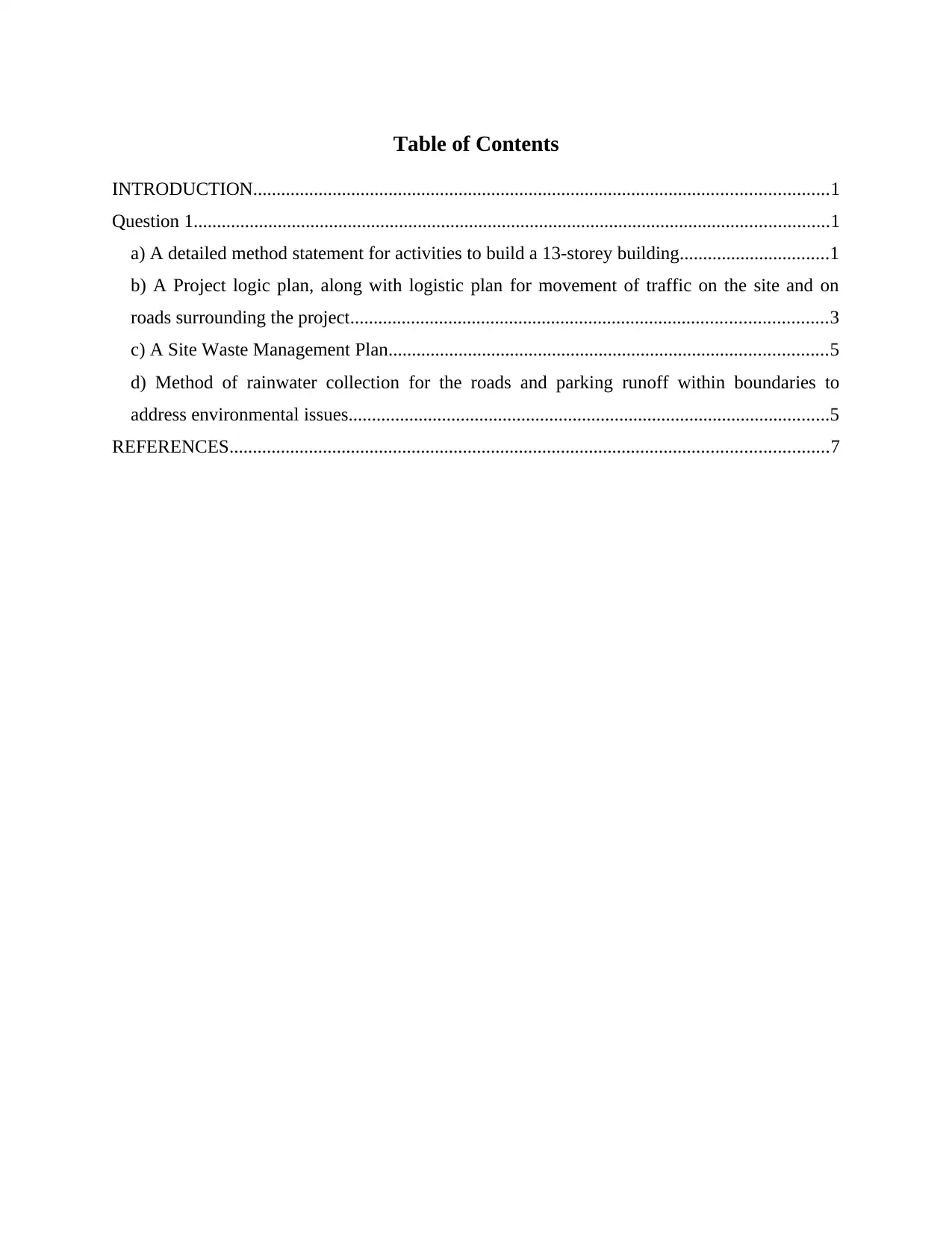
Table of Contents
INTRODUCTION...........................................................................................................................1
Question 1........................................................................................................................................1
a) A detailed method statement for activities to build a 13-storey building................................1
b) A Project logic plan, along with logistic plan for movement of traffic on the site and on
roads surrounding the project......................................................................................................3
c) A Site Waste Management Plan..............................................................................................5
d) Method of rainwater collection for the roads and parking runoff within boundaries to
address environmental issues.......................................................................................................5
REFERENCES................................................................................................................................7
INTRODUCTION...........................................................................................................................1
Question 1........................................................................................................................................1
a) A detailed method statement for activities to build a 13-storey building................................1
b) A Project logic plan, along with logistic plan for movement of traffic on the site and on
roads surrounding the project......................................................................................................3
c) A Site Waste Management Plan..............................................................................................5
d) Method of rainwater collection for the roads and parking runoff within boundaries to
address environmental issues.......................................................................................................5
REFERENCES................................................................................................................................7

⊘ This is a preview!⊘
Do you want full access?
Subscribe today to unlock all pages.

Trusted by 1+ million students worldwide
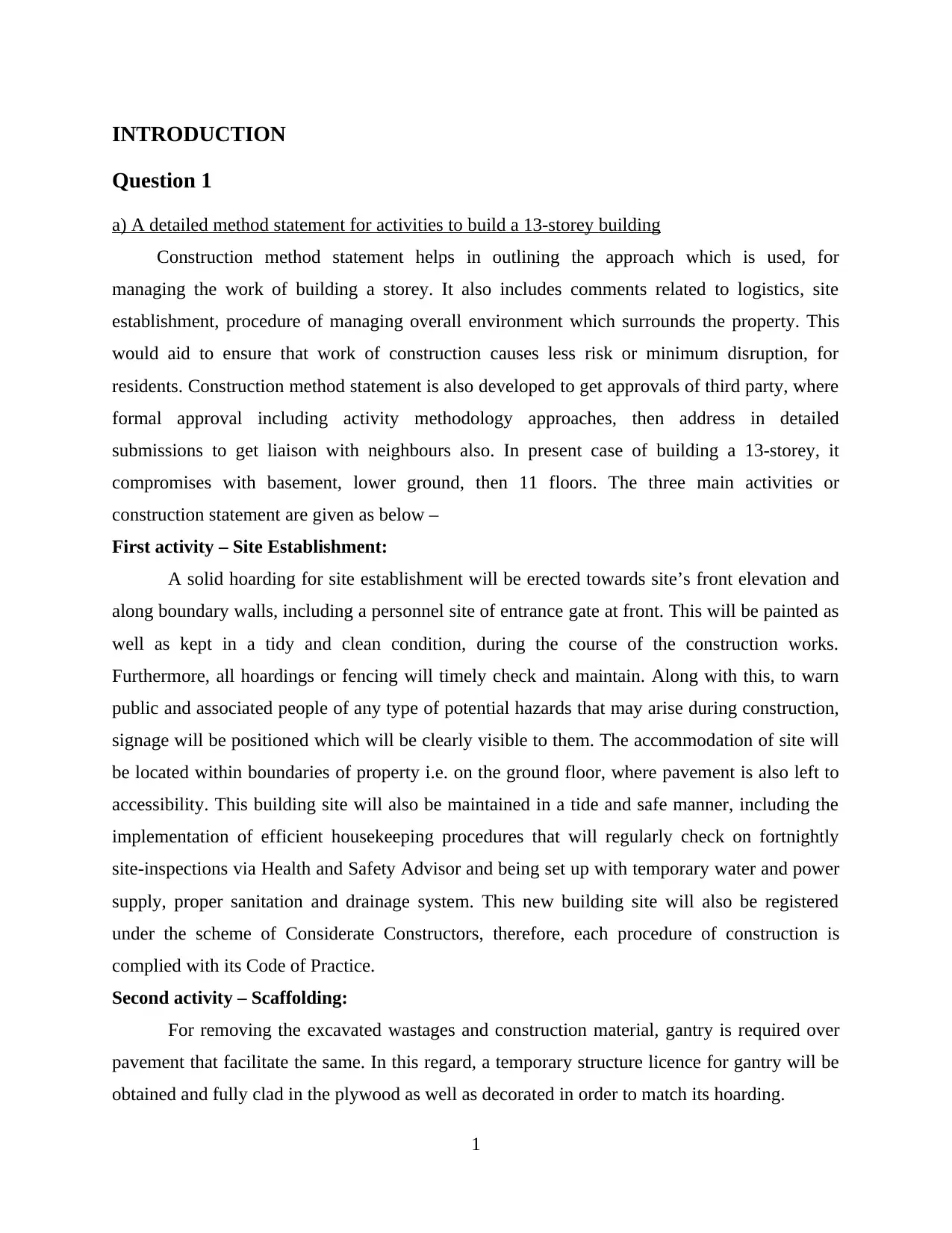
INTRODUCTION
Question 1
a) A detailed method statement for activities to build a 13-storey building
Construction method statement helps in outlining the approach which is used, for
managing the work of building a storey. It also includes comments related to logistics, site
establishment, procedure of managing overall environment which surrounds the property. This
would aid to ensure that work of construction causes less risk or minimum disruption, for
residents. Construction method statement is also developed to get approvals of third party, where
formal approval including activity methodology approaches, then address in detailed
submissions to get liaison with neighbours also. In present case of building a 13-storey, it
compromises with basement, lower ground, then 11 floors. The three main activities or
construction statement are given as below –
First activity – Site Establishment:
A solid hoarding for site establishment will be erected towards site’s front elevation and
along boundary walls, including a personnel site of entrance gate at front. This will be painted as
well as kept in a tidy and clean condition, during the course of the construction works.
Furthermore, all hoardings or fencing will timely check and maintain. Along with this, to warn
public and associated people of any type of potential hazards that may arise during construction,
signage will be positioned which will be clearly visible to them. The accommodation of site will
be located within boundaries of property i.e. on the ground floor, where pavement is also left to
accessibility. This building site will also be maintained in a tide and safe manner, including the
implementation of efficient housekeeping procedures that will regularly check on fortnightly
site-inspections via Health and Safety Advisor and being set up with temporary water and power
supply, proper sanitation and drainage system. This new building site will also be registered
under the scheme of Considerate Constructors, therefore, each procedure of construction is
complied with its Code of Practice.
Second activity – Scaffolding:
For removing the excavated wastages and construction material, gantry is required over
pavement that facilitate the same. In this regard, a temporary structure licence for gantry will be
obtained and fully clad in the plywood as well as decorated in order to match its hoarding.
1
Question 1
a) A detailed method statement for activities to build a 13-storey building
Construction method statement helps in outlining the approach which is used, for
managing the work of building a storey. It also includes comments related to logistics, site
establishment, procedure of managing overall environment which surrounds the property. This
would aid to ensure that work of construction causes less risk or minimum disruption, for
residents. Construction method statement is also developed to get approvals of third party, where
formal approval including activity methodology approaches, then address in detailed
submissions to get liaison with neighbours also. In present case of building a 13-storey, it
compromises with basement, lower ground, then 11 floors. The three main activities or
construction statement are given as below –
First activity – Site Establishment:
A solid hoarding for site establishment will be erected towards site’s front elevation and
along boundary walls, including a personnel site of entrance gate at front. This will be painted as
well as kept in a tidy and clean condition, during the course of the construction works.
Furthermore, all hoardings or fencing will timely check and maintain. Along with this, to warn
public and associated people of any type of potential hazards that may arise during construction,
signage will be positioned which will be clearly visible to them. The accommodation of site will
be located within boundaries of property i.e. on the ground floor, where pavement is also left to
accessibility. This building site will also be maintained in a tide and safe manner, including the
implementation of efficient housekeeping procedures that will regularly check on fortnightly
site-inspections via Health and Safety Advisor and being set up with temporary water and power
supply, proper sanitation and drainage system. This new building site will also be registered
under the scheme of Considerate Constructors, therefore, each procedure of construction is
complied with its Code of Practice.
Second activity – Scaffolding:
For removing the excavated wastages and construction material, gantry is required over
pavement that facilitate the same. In this regard, a temporary structure licence for gantry will be
obtained and fully clad in the plywood as well as decorated in order to match its hoarding.
1
Paraphrase This Document
Need a fresh take? Get an instant paraphrase of this document with our AI Paraphraser
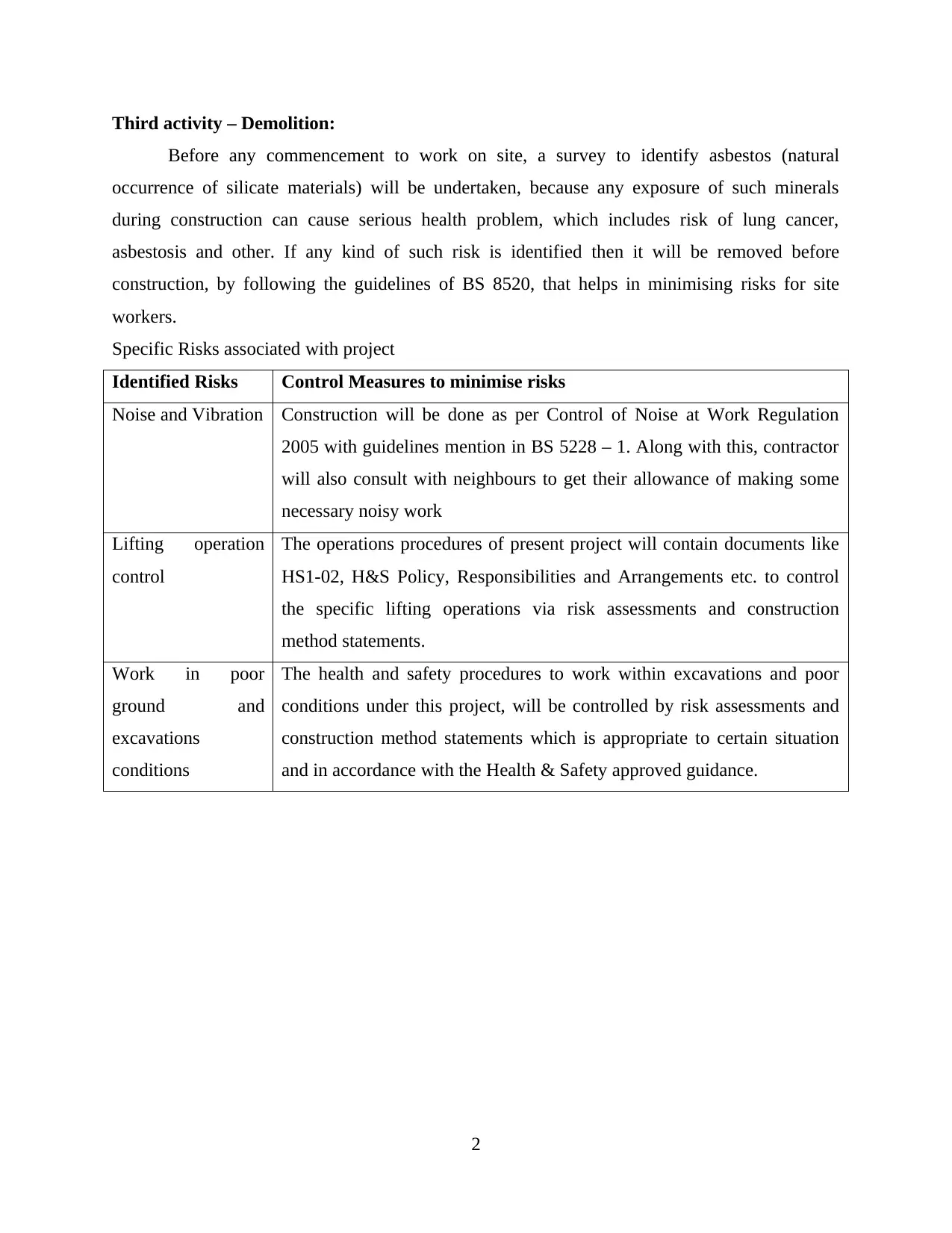
Third activity – Demolition:
Before any commencement to work on site, a survey to identify asbestos (natural
occurrence of silicate materials) will be undertaken, because any exposure of such minerals
during construction can cause serious health problem, which includes risk of lung cancer,
asbestosis and other. If any kind of such risk is identified then it will be removed before
construction, by following the guidelines of BS 8520, that helps in minimising risks for site
workers.
Specific Risks associated with project
Identified Risks Control Measures to minimise risks
Noise and Vibration Construction will be done as per Control of Noise at Work Regulation
2005 with guidelines mention in BS 5228 – 1. Along with this, contractor
will also consult with neighbours to get their allowance of making some
necessary noisy work
Lifting operation
control
The operations procedures of present project will contain documents like
HS1-02, H&S Policy, Responsibilities and Arrangements etc. to control
the specific lifting operations via risk assessments and construction
method statements.
Work in poor
ground and
excavations
conditions
The health and safety procedures to work within excavations and poor
conditions under this project, will be controlled by risk assessments and
construction method statements which is appropriate to certain situation
and in accordance with the Health & Safety approved guidance.
2
Before any commencement to work on site, a survey to identify asbestos (natural
occurrence of silicate materials) will be undertaken, because any exposure of such minerals
during construction can cause serious health problem, which includes risk of lung cancer,
asbestosis and other. If any kind of such risk is identified then it will be removed before
construction, by following the guidelines of BS 8520, that helps in minimising risks for site
workers.
Specific Risks associated with project
Identified Risks Control Measures to minimise risks
Noise and Vibration Construction will be done as per Control of Noise at Work Regulation
2005 with guidelines mention in BS 5228 – 1. Along with this, contractor
will also consult with neighbours to get their allowance of making some
necessary noisy work
Lifting operation
control
The operations procedures of present project will contain documents like
HS1-02, H&S Policy, Responsibilities and Arrangements etc. to control
the specific lifting operations via risk assessments and construction
method statements.
Work in poor
ground and
excavations
conditions
The health and safety procedures to work within excavations and poor
conditions under this project, will be controlled by risk assessments and
construction method statements which is appropriate to certain situation
and in accordance with the Health & Safety approved guidance.
2
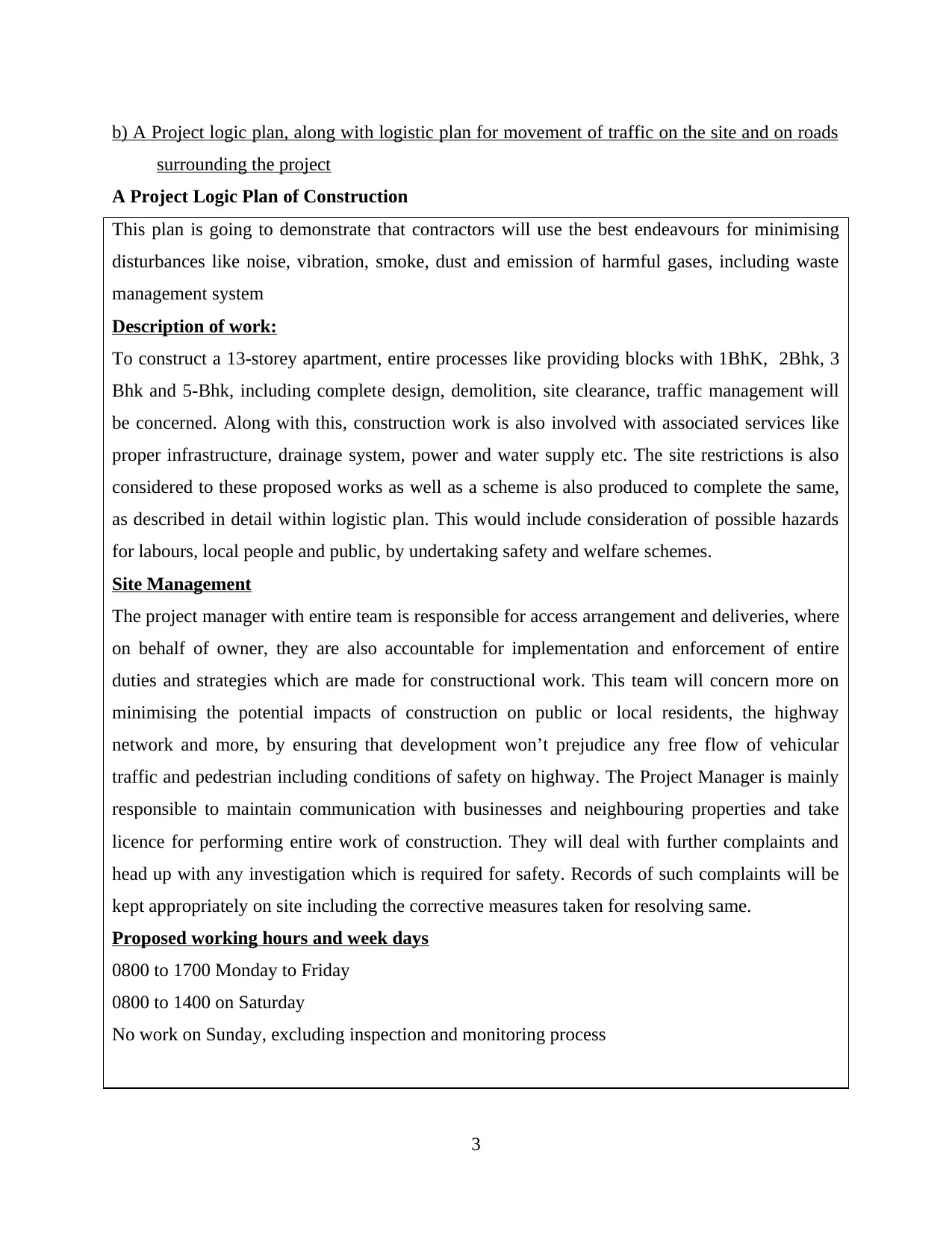
b) A Project logic plan, along with logistic plan for movement of traffic on the site and on roads
surrounding the project
A Project Logic Plan of Construction
This plan is going to demonstrate that contractors will use the best endeavours for minimising
disturbances like noise, vibration, smoke, dust and emission of harmful gases, including waste
management system
Description of work:
To construct a 13-storey apartment, entire processes like providing blocks with 1BhK, 2Bhk, 3
Bhk and 5-Bhk, including complete design, demolition, site clearance, traffic management will
be concerned. Along with this, construction work is also involved with associated services like
proper infrastructure, drainage system, power and water supply etc. The site restrictions is also
considered to these proposed works as well as a scheme is also produced to complete the same,
as described in detail within logistic plan. This would include consideration of possible hazards
for labours, local people and public, by undertaking safety and welfare schemes.
Site Management
The project manager with entire team is responsible for access arrangement and deliveries, where
on behalf of owner, they are also accountable for implementation and enforcement of entire
duties and strategies which are made for constructional work. This team will concern more on
minimising the potential impacts of construction on public or local residents, the highway
network and more, by ensuring that development won’t prejudice any free flow of vehicular
traffic and pedestrian including conditions of safety on highway. The Project Manager is mainly
responsible to maintain communication with businesses and neighbouring properties and take
licence for performing entire work of construction. They will deal with further complaints and
head up with any investigation which is required for safety. Records of such complaints will be
kept appropriately on site including the corrective measures taken for resolving same.
Proposed working hours and week days
0800 to 1700 Monday to Friday
0800 to 1400 on Saturday
No work on Sunday, excluding inspection and monitoring process
3
surrounding the project
A Project Logic Plan of Construction
This plan is going to demonstrate that contractors will use the best endeavours for minimising
disturbances like noise, vibration, smoke, dust and emission of harmful gases, including waste
management system
Description of work:
To construct a 13-storey apartment, entire processes like providing blocks with 1BhK, 2Bhk, 3
Bhk and 5-Bhk, including complete design, demolition, site clearance, traffic management will
be concerned. Along with this, construction work is also involved with associated services like
proper infrastructure, drainage system, power and water supply etc. The site restrictions is also
considered to these proposed works as well as a scheme is also produced to complete the same,
as described in detail within logistic plan. This would include consideration of possible hazards
for labours, local people and public, by undertaking safety and welfare schemes.
Site Management
The project manager with entire team is responsible for access arrangement and deliveries, where
on behalf of owner, they are also accountable for implementation and enforcement of entire
duties and strategies which are made for constructional work. This team will concern more on
minimising the potential impacts of construction on public or local residents, the highway
network and more, by ensuring that development won’t prejudice any free flow of vehicular
traffic and pedestrian including conditions of safety on highway. The Project Manager is mainly
responsible to maintain communication with businesses and neighbouring properties and take
licence for performing entire work of construction. They will deal with further complaints and
head up with any investigation which is required for safety. Records of such complaints will be
kept appropriately on site including the corrective measures taken for resolving same.
Proposed working hours and week days
0800 to 1700 Monday to Friday
0800 to 1400 on Saturday
No work on Sunday, excluding inspection and monitoring process
3
⊘ This is a preview!⊘
Do you want full access?
Subscribe today to unlock all pages.

Trusted by 1+ million students worldwide
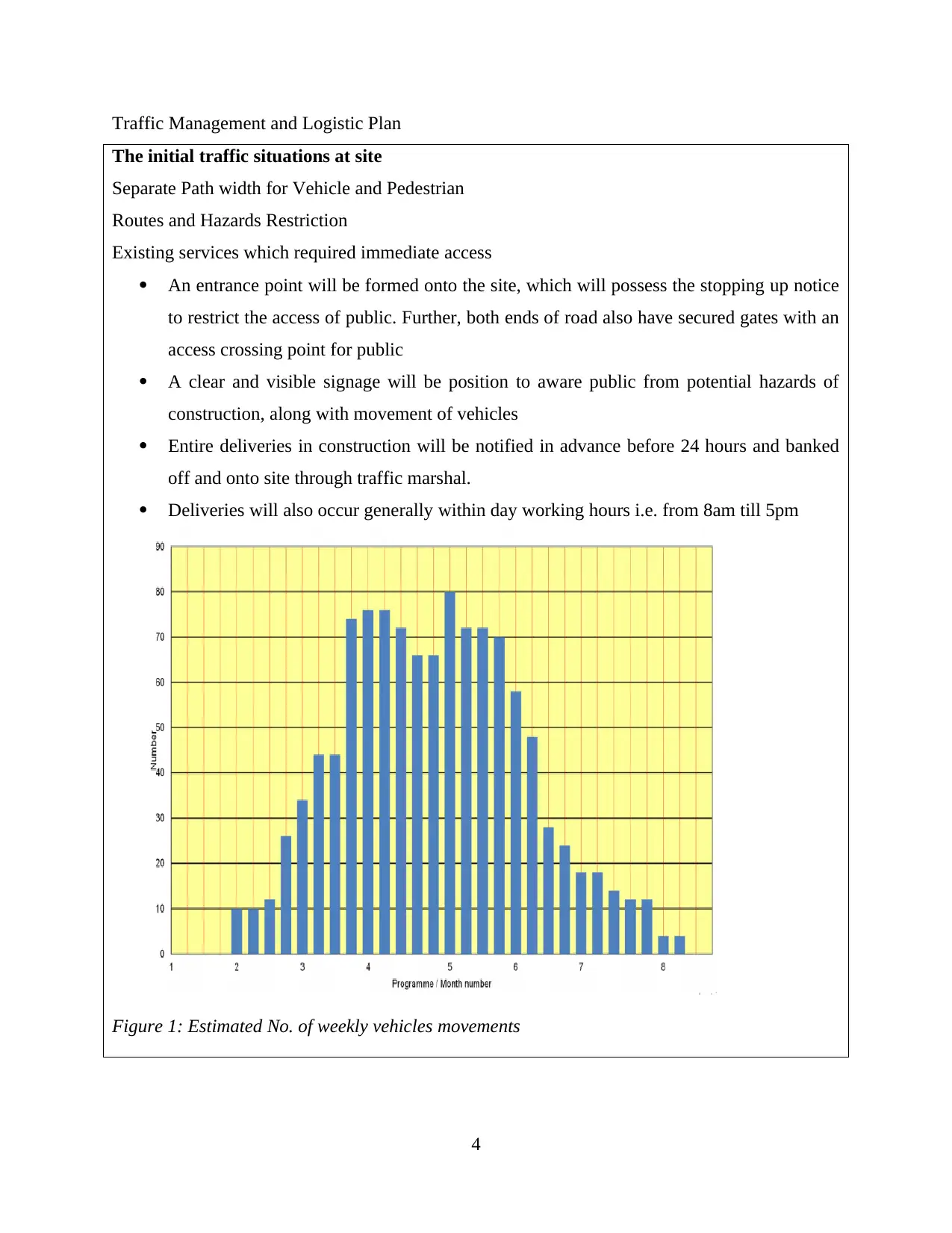
Traffic Management and Logistic Plan
The initial traffic situations at site
Separate Path width for Vehicle and Pedestrian
Routes and Hazards Restriction
Existing services which required immediate access
An entrance point will be formed onto the site, which will possess the stopping up notice
to restrict the access of public. Further, both ends of road also have secured gates with an
access crossing point for public
A clear and visible signage will be position to aware public from potential hazards of
construction, along with movement of vehicles
Entire deliveries in construction will be notified in advance before 24 hours and banked
off and onto site through traffic marshal.
Deliveries will also occur generally within day working hours i.e. from 8am till 5pm
Figure 1: Estimated No. of weekly vehicles movements
4
The initial traffic situations at site
Separate Path width for Vehicle and Pedestrian
Routes and Hazards Restriction
Existing services which required immediate access
An entrance point will be formed onto the site, which will possess the stopping up notice
to restrict the access of public. Further, both ends of road also have secured gates with an
access crossing point for public
A clear and visible signage will be position to aware public from potential hazards of
construction, along with movement of vehicles
Entire deliveries in construction will be notified in advance before 24 hours and banked
off and onto site through traffic marshal.
Deliveries will also occur generally within day working hours i.e. from 8am till 5pm
Figure 1: Estimated No. of weekly vehicles movements
4
Paraphrase This Document
Need a fresh take? Get an instant paraphrase of this document with our AI Paraphraser
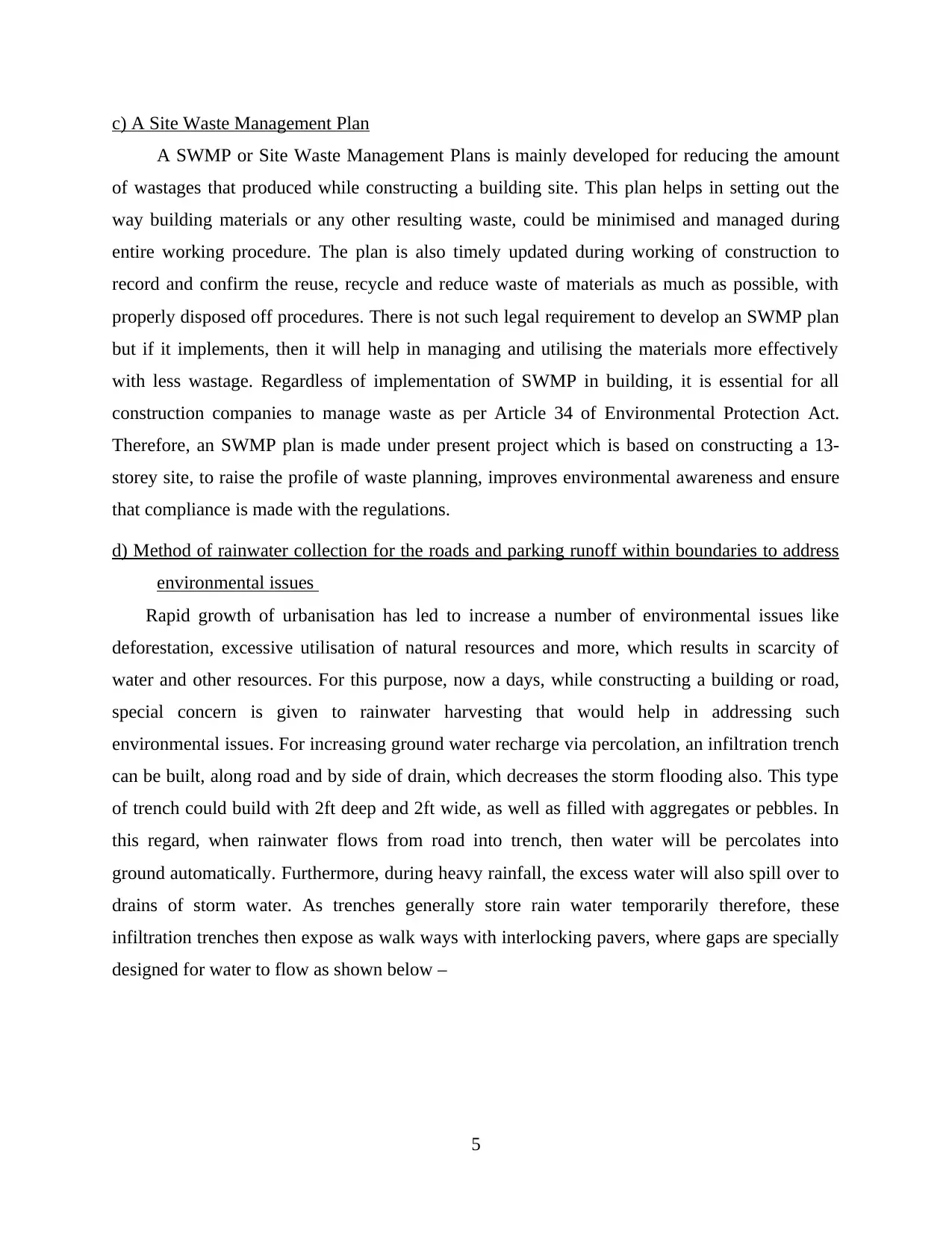
c) A Site Waste Management Plan
A SWMP or Site Waste Management Plans is mainly developed for reducing the amount
of wastages that produced while constructing a building site. This plan helps in setting out the
way building materials or any other resulting waste, could be minimised and managed during
entire working procedure. The plan is also timely updated during working of construction to
record and confirm the reuse, recycle and reduce waste of materials as much as possible, with
properly disposed off procedures. There is not such legal requirement to develop an SWMP plan
but if it implements, then it will help in managing and utilising the materials more effectively
with less wastage. Regardless of implementation of SWMP in building, it is essential for all
construction companies to manage waste as per Article 34 of Environmental Protection Act.
Therefore, an SWMP plan is made under present project which is based on constructing a 13-
storey site, to raise the profile of waste planning, improves environmental awareness and ensure
that compliance is made with the regulations.
d) Method of rainwater collection for the roads and parking runoff within boundaries to address
environmental issues
Rapid growth of urbanisation has led to increase a number of environmental issues like
deforestation, excessive utilisation of natural resources and more, which results in scarcity of
water and other resources. For this purpose, now a days, while constructing a building or road,
special concern is given to rainwater harvesting that would help in addressing such
environmental issues. For increasing ground water recharge via percolation, an infiltration trench
can be built, along road and by side of drain, which decreases the storm flooding also. This type
of trench could build with 2ft deep and 2ft wide, as well as filled with aggregates or pebbles. In
this regard, when rainwater flows from road into trench, then water will be percolates into
ground automatically. Furthermore, during heavy rainfall, the excess water will also spill over to
drains of storm water. As trenches generally store rain water temporarily therefore, these
infiltration trenches then expose as walk ways with interlocking pavers, where gaps are specially
designed for water to flow as shown below –
5
A SWMP or Site Waste Management Plans is mainly developed for reducing the amount
of wastages that produced while constructing a building site. This plan helps in setting out the
way building materials or any other resulting waste, could be minimised and managed during
entire working procedure. The plan is also timely updated during working of construction to
record and confirm the reuse, recycle and reduce waste of materials as much as possible, with
properly disposed off procedures. There is not such legal requirement to develop an SWMP plan
but if it implements, then it will help in managing and utilising the materials more effectively
with less wastage. Regardless of implementation of SWMP in building, it is essential for all
construction companies to manage waste as per Article 34 of Environmental Protection Act.
Therefore, an SWMP plan is made under present project which is based on constructing a 13-
storey site, to raise the profile of waste planning, improves environmental awareness and ensure
that compliance is made with the regulations.
d) Method of rainwater collection for the roads and parking runoff within boundaries to address
environmental issues
Rapid growth of urbanisation has led to increase a number of environmental issues like
deforestation, excessive utilisation of natural resources and more, which results in scarcity of
water and other resources. For this purpose, now a days, while constructing a building or road,
special concern is given to rainwater harvesting that would help in addressing such
environmental issues. For increasing ground water recharge via percolation, an infiltration trench
can be built, along road and by side of drain, which decreases the storm flooding also. This type
of trench could build with 2ft deep and 2ft wide, as well as filled with aggregates or pebbles. In
this regard, when rainwater flows from road into trench, then water will be percolates into
ground automatically. Furthermore, during heavy rainfall, the excess water will also spill over to
drains of storm water. As trenches generally store rain water temporarily therefore, these
infiltration trenches then expose as walk ways with interlocking pavers, where gaps are specially
designed for water to flow as shown below –
5
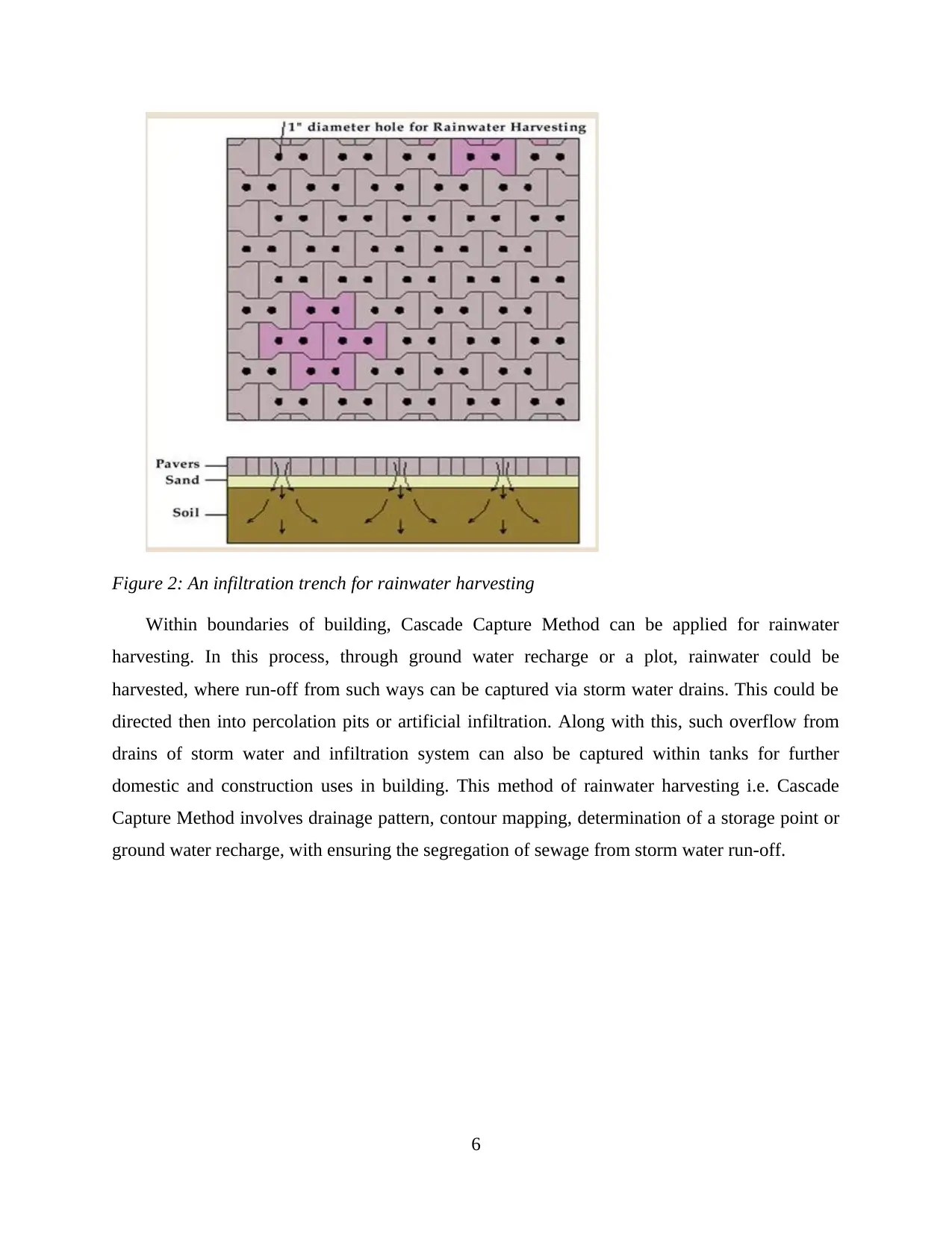
Figure 2: An infiltration trench for rainwater harvesting
Within boundaries of building, Cascade Capture Method can be applied for rainwater
harvesting. In this process, through ground water recharge or a plot, rainwater could be
harvested, where run-off from such ways can be captured via storm water drains. This could be
directed then into percolation pits or artificial infiltration. Along with this, such overflow from
drains of storm water and infiltration system can also be captured within tanks for further
domestic and construction uses in building. This method of rainwater harvesting i.e. Cascade
Capture Method involves drainage pattern, contour mapping, determination of a storage point or
ground water recharge, with ensuring the segregation of sewage from storm water run-off.
6
Within boundaries of building, Cascade Capture Method can be applied for rainwater
harvesting. In this process, through ground water recharge or a plot, rainwater could be
harvested, where run-off from such ways can be captured via storm water drains. This could be
directed then into percolation pits or artificial infiltration. Along with this, such overflow from
drains of storm water and infiltration system can also be captured within tanks for further
domestic and construction uses in building. This method of rainwater harvesting i.e. Cascade
Capture Method involves drainage pattern, contour mapping, determination of a storage point or
ground water recharge, with ensuring the segregation of sewage from storm water run-off.
6
⊘ This is a preview!⊘
Do you want full access?
Subscribe today to unlock all pages.

Trusted by 1+ million students worldwide
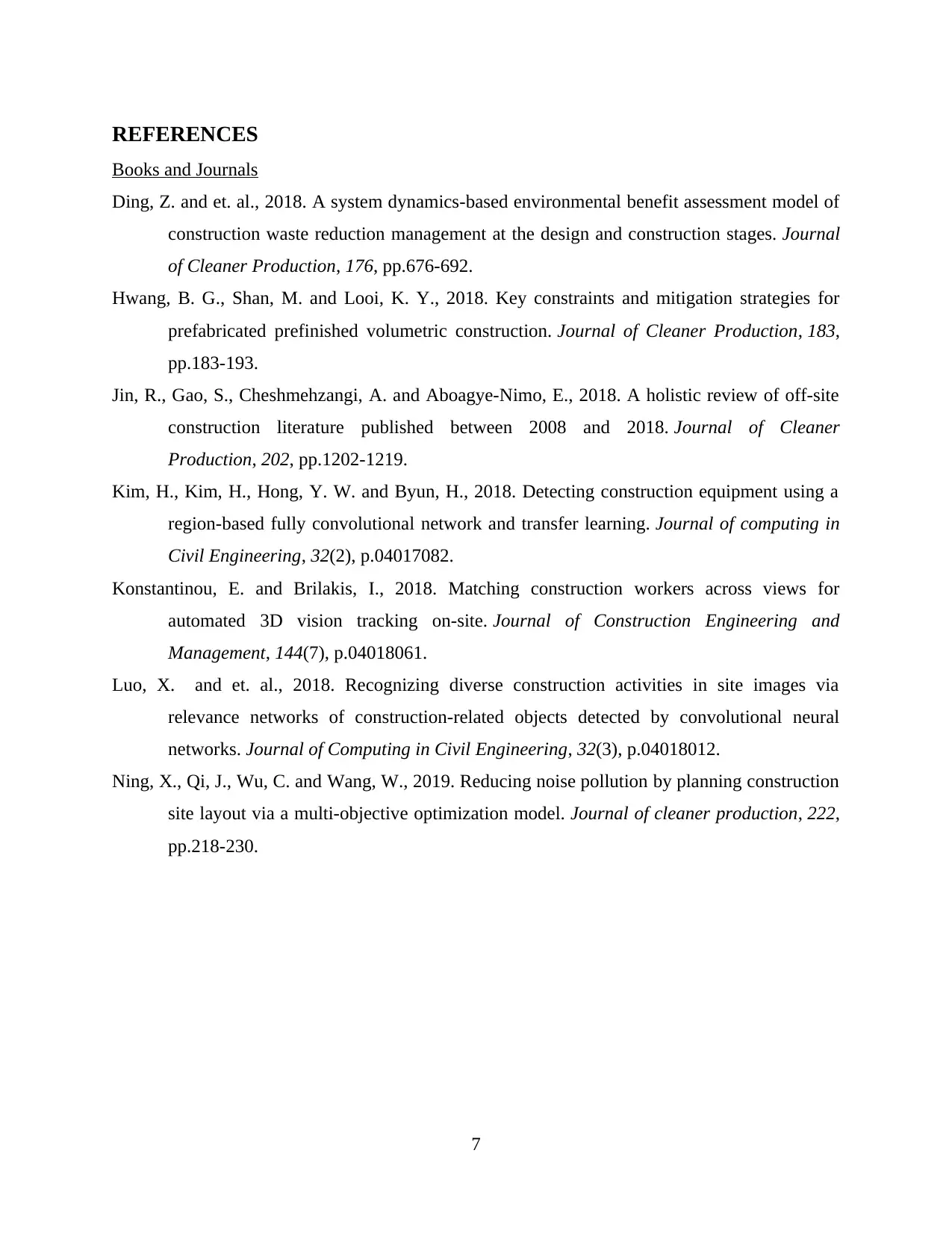
REFERENCES
Books and Journals
Ding, Z. and et. al., 2018. A system dynamics-based environmental benefit assessment model of
construction waste reduction management at the design and construction stages. Journal
of Cleaner Production, 176, pp.676-692.
Hwang, B. G., Shan, M. and Looi, K. Y., 2018. Key constraints and mitigation strategies for
prefabricated prefinished volumetric construction. Journal of Cleaner Production, 183,
pp.183-193.
Jin, R., Gao, S., Cheshmehzangi, A. and Aboagye-Nimo, E., 2018. A holistic review of off-site
construction literature published between 2008 and 2018. Journal of Cleaner
Production, 202, pp.1202-1219.
Kim, H., Kim, H., Hong, Y. W. and Byun, H., 2018. Detecting construction equipment using a
region-based fully convolutional network and transfer learning. Journal of computing in
Civil Engineering, 32(2), p.04017082.
Konstantinou, E. and Brilakis, I., 2018. Matching construction workers across views for
automated 3D vision tracking on-site. Journal of Construction Engineering and
Management, 144(7), p.04018061.
Luo, X. and et. al., 2018. Recognizing diverse construction activities in site images via
relevance networks of construction-related objects detected by convolutional neural
networks. Journal of Computing in Civil Engineering, 32(3), p.04018012.
Ning, X., Qi, J., Wu, C. and Wang, W., 2019. Reducing noise pollution by planning construction
site layout via a multi-objective optimization model. Journal of cleaner production, 222,
pp.218-230.
7
Books and Journals
Ding, Z. and et. al., 2018. A system dynamics-based environmental benefit assessment model of
construction waste reduction management at the design and construction stages. Journal
of Cleaner Production, 176, pp.676-692.
Hwang, B. G., Shan, M. and Looi, K. Y., 2018. Key constraints and mitigation strategies for
prefabricated prefinished volumetric construction. Journal of Cleaner Production, 183,
pp.183-193.
Jin, R., Gao, S., Cheshmehzangi, A. and Aboagye-Nimo, E., 2018. A holistic review of off-site
construction literature published between 2008 and 2018. Journal of Cleaner
Production, 202, pp.1202-1219.
Kim, H., Kim, H., Hong, Y. W. and Byun, H., 2018. Detecting construction equipment using a
region-based fully convolutional network and transfer learning. Journal of computing in
Civil Engineering, 32(2), p.04017082.
Konstantinou, E. and Brilakis, I., 2018. Matching construction workers across views for
automated 3D vision tracking on-site. Journal of Construction Engineering and
Management, 144(7), p.04018061.
Luo, X. and et. al., 2018. Recognizing diverse construction activities in site images via
relevance networks of construction-related objects detected by convolutional neural
networks. Journal of Computing in Civil Engineering, 32(3), p.04018012.
Ning, X., Qi, J., Wu, C. and Wang, W., 2019. Reducing noise pollution by planning construction
site layout via a multi-objective optimization model. Journal of cleaner production, 222,
pp.218-230.
7
1 out of 10
Related Documents
Your All-in-One AI-Powered Toolkit for Academic Success.
+13062052269
info@desklib.com
Available 24*7 on WhatsApp / Email
![[object Object]](/_next/static/media/star-bottom.7253800d.svg)
Unlock your academic potential
Copyright © 2020–2025 A2Z Services. All Rights Reserved. Developed and managed by ZUCOL.




